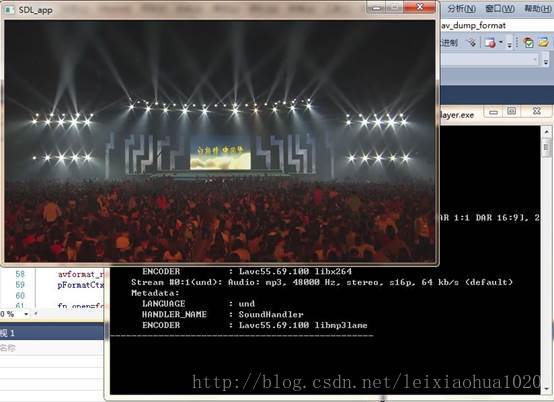最简单的基于FFmpeg的内存读写的例子:内存播放器
2016-08-06 00:00
525 查看
=====================================================
最简单的基于FFmpeg的内存读写的例子系列文章列表:
最简单的基于FFmpeg的内存读写的例子:内存播放器
最简单的基于FFmpeg的内存读写的例子:内存转码器
=====================================================
打算记录两个最简单的FFmpeg进行内存读写的例子。之前的所有有关FFmpeg的例子都是对文件进行操作的。例如《100行代码实现最简单的基于FFMPEG+SDL的视频播放器》播放的是一个视频的文件。而《最简单的基于FFMPEG的转码程序》也是将一个视频文件转换为另一个视频文件。《最简单的基于FFmpeg的视频编码器(YUV编码为H.264)》也是最后编码得到一个H.264视频文件。实际上,并不是所有视频的编码,解码都是针对文件进行处理的。有的时候需要的解码的视频数据在一段内存中。例如,通过其他系统送来的视频数据。同样,有的时候编码后的视频数据也未必要保存成一个文件。例如,要求将编码后的视频数据送给其他的系统进行下一步的处理。以上两种情况就要求FFmpeg不仅仅是对文件进行“读,写”操作,而是要对内存进行“读,写”操作。因此打算记录的两个例子就是使用FFmpeg对内存进行读写的例子。
有关FFmpeg读写内存的例子已经在文章《ffmpeg 从内存中读取数据(或将数据输出到内存)》中有过叙述,但是一直没有做完整代码的工程。本文记录《最简单的基于FFmpeg内存播放器》。该例子中,首先将文件中的视频数据通过fread()读取到内存中,然后使用FFmpeg播放内存中的数据。
下篇文章计划记录的第二个例子是《最简单的基于FFmpeg内存转码器》。该例子中,首先将文件中的视频数据通过fread()读取到内存中,然后使用FFmpeg读取该数据并进行转码,接着将转码后的数据输出到另一块内存中,最后将该数据通过fwrite()写入成文件。
关于如何从内存中读取数据在这里不再详述,可以参考文章:
ffmpeg 从内存中读取数据(或将数据输出到内存)
1. 初始化自定义的AVIOContext,指定自定义的回调函数。示例代码如下:
上述代码中,自定义了回调函数read_buffer()。在使用avformat_open_input()打开媒体数据的时候,就可以不指定文件的URL了,即其第2个参数为NULL(因为数据不是靠文件读取,而是由read_buffer()提供)
2. 自己写回调函数。示例代码如下:
当系统需要数据的时候,会自动调用该回调函数以获取数据。这个例子为了简单,直接使用fread()读取数据至内存。回调函数需要格外注意它的参数和返回值。
可以通过代码定义的宏来确定是否将解码后的YUV420P数据输出成文件:

项目主页
SourceForge:https://sourceforge.net/projects/simplestffmpegmemhandler/
Github:https://github.com/leixiaohua1020/simplest_ffmpeg_mem_handler
开源中国:http://git.oschina.net/leixiaohua1020/simplest_ffmpeg_mem_handler
CSDN下载地址:
http://download.csdn.net/detail/leixiaohua1020/8003731
本工程包含两个FFmpeg读写内存的例子:
simplest_ffmpeg_mem_player:基于FFmpeg的内存播放器。
simplest_ffmpeg_mem_transcoder:基于FFmpeg的内存转码器(下篇文章记录)。
更新-1.1 (2015.2.13)=========================================
这次考虑到了跨平台的要求,调整了源代码。经过这次调整之后,源代码可以在以下平台编译通过:
VC++:打开sln文件即可编译,无需配置。
cl.exe:打开compile_cl.bat即可命令行下使用cl.exe进行编译,注意可能需要按照VC的安装路径调整脚本里面的参数。编译命令如下。
MinGW:MinGW命令行下运行compile_mingw.sh即可使用MinGW的g++进行编译。编译命令如下。
GCC(Linux):Linux命令行下运行compile_gcc.sh即可使用GCC进行编译。编译命令如下。
GCC(MacOS):Mac终端下运行compile_gcc_mac.sh即可使用Mac 的GCC进行编译,Mac的GCC和Linux的GCC差别不大,但是使用SDL1.2的时候,必须加上“-framework Cocoa”参数,否则编译无法通过。编译命令如下。
PS:相关的编译命令已经保存到了工程文件夹中
CSDN下载地址:http://download.csdn.net/detail/leixiaohua1020/8445795
SourceForge上已经更新。
最简单的基于FFmpeg的内存读写的例子系列文章列表:
最简单的基于FFmpeg的内存读写的例子:内存播放器
最简单的基于FFmpeg的内存读写的例子:内存转码器
=====================================================
打算记录两个最简单的FFmpeg进行内存读写的例子。之前的所有有关FFmpeg的例子都是对文件进行操作的。例如《100行代码实现最简单的基于FFMPEG+SDL的视频播放器》播放的是一个视频的文件。而《最简单的基于FFMPEG的转码程序》也是将一个视频文件转换为另一个视频文件。《最简单的基于FFmpeg的视频编码器(YUV编码为H.264)》也是最后编码得到一个H.264视频文件。实际上,并不是所有视频的编码,解码都是针对文件进行处理的。有的时候需要的解码的视频数据在一段内存中。例如,通过其他系统送来的视频数据。同样,有的时候编码后的视频数据也未必要保存成一个文件。例如,要求将编码后的视频数据送给其他的系统进行下一步的处理。以上两种情况就要求FFmpeg不仅仅是对文件进行“读,写”操作,而是要对内存进行“读,写”操作。因此打算记录的两个例子就是使用FFmpeg对内存进行读写的例子。
有关FFmpeg读写内存的例子已经在文章《ffmpeg 从内存中读取数据(或将数据输出到内存)》中有过叙述,但是一直没有做完整代码的工程。本文记录《最简单的基于FFmpeg内存播放器》。该例子中,首先将文件中的视频数据通过fread()读取到内存中,然后使用FFmpeg播放内存中的数据。
下篇文章计划记录的第二个例子是《最简单的基于FFmpeg内存转码器》。该例子中,首先将文件中的视频数据通过fread()读取到内存中,然后使用FFmpeg读取该数据并进行转码,接着将转码后的数据输出到另一块内存中,最后将该数据通过fwrite()写入成文件。
关于如何从内存中读取数据在这里不再详述,可以参考文章:
ffmpeg 从内存中读取数据(或将数据输出到内存)
关键点
关键点就两个:1. 初始化自定义的AVIOContext,指定自定义的回调函数。示例代码如下:
//AVIOContext中的缓存
unsigned char *aviobuffer=(unsigned char*)av_malloc(32768);
AVIOContext *avio=avio_alloc_context(aviobuffer, 32768,0,NULL,read_buffer,NULL,NULL);
pFormatCtx->pb=avio;
if(avformat_open_input(&pFormatCtx,NULL,NULL,NULL)!=0){
printf("Couldn't open inputstream.(无法打开输入流)\n");
return -1;
}上述代码中,自定义了回调函数read_buffer()。在使用avformat_open_input()打开媒体数据的时候,就可以不指定文件的URL了,即其第2个参数为NULL(因为数据不是靠文件读取,而是由read_buffer()提供)
2. 自己写回调函数。示例代码如下:
//Callback
int read_buffer(void *opaque, uint8_t *buf, int buf_size){
if(!feof(fp_open)){
inttrue_size=fread(buf,1,buf_size,fp_open);
return true_size;
}else{
return -1;
}
}当系统需要数据的时候,会自动调用该回调函数以获取数据。这个例子为了简单,直接使用fread()读取数据至内存。回调函数需要格外注意它的参数和返回值。
源代码
下面直接贴上程序的源代码:/** * 最简单的基于FFmpeg的内存读写例子(内存播放器) * Simplest FFmpeg mem Player * * 雷霄骅 * leixiaohua1020@126.com * 中国传媒大学/数字电视技术 * Communication University of China / Digital TV Technology * http://blog.csdn.net/leixiaohua1020 * * 本程序实现了对内存中的视频数据的播放。 * 是最简单的使用FFmpeg读内存的例子。 * * This software play video data in memory (not a file). * It's the simplest example to use FFmpeg to read from memory. * */ #include <stdio.h> #define __STDC_CONSTANT_MACROS #ifdef _WIN32 //Windows extern "C" { #include "libavcodec/avcodec.h" #include "libavformat/avformat.h" #include "libswscale/swscale.h" #include "SDL/SDL.h" }; #else //Linux... #ifdef __cplusplus extern "C" { #endif #include <libavcodec/avcodec.h> #include <libavformat/avformat.h> #include <libswscale/swscale.h> #include <SDL/SDL.h> #ifdef __cplusplus }; #endif #endif //Output YUV420P #define OUTPUT_YUV420P 0 FILE *fp_open=NULL; //Callback int read_buffer(void *opaque, uint8_t *buf, int buf_size){ if(!feof(fp_open)){ int true_size=fread(buf,1,buf_size,fp_open); return true_size; }else{ return -1; } } int main(int argc, char* argv[]) { AVFormatContext *pFormatCtx; int i, videoindex; AVCodecContext *pCodecCtx; AVCodec *pCodec; char filepath[]="cuc60anniversary_start.mkv"; av_register_all(); avformat_network_init(); pFormatCtx = avformat_alloc_context(); fp_open=fopen(filepath,"rb+"); //Init AVIOContext unsigned char *aviobuffer=(unsigned char *)av_malloc(32768); AVIOContext *avio =avio_alloc_context(aviobuffer, 32768,0,NULL,read_buffer,NULL,NULL); pFormatCtx->pb=avio; if(avformat_open_input(&pFormatCtx,NULL,NULL,NULL)!=0){ printf("Couldn't open input stream.\n"); return -1; } if(avformat_find_stream_info(pFormatCtx,NULL)<0){ printf("Couldn't find stream information.\n"); return -1; } videoindex=-1; for(i=0; i<pFormatCtx->nb_streams; i++) if(pFormatCtx->streams[i]->codec->codec_type==AVMEDIA_TYPE_VIDEO){ videoindex=i; break; } if(videoindex==-1){ printf("Didn't find a video stream.\n"); return -1; } pCodecCtx=pFormatCtx->streams[videoindex]->codec; pCodec=avcodec_find_decoder(pCodecCtx->codec_id); if(pCodec==NULL){ printf("Codec not found.\n"); return -1; } if(avcodec_open2(pCodecCtx, pCodec,NULL)<0){ printf("Could not open codec.\n"); return -1; } AVFrame *pFrame,*pFrameYUV; pFrame=av_frame_alloc(); pFrameYUV=av_frame_alloc(); //uint8_t *out_buffer=(uint8_t *)av_malloc(avpicture_get_size(AV_PIX_FMT_YUV420P, pCodecCtx->width, pCodecCtx->height)); //avpicture_fill((AVPicture *)pFrameYUV, out_buffer, AV_PIX_FMT_YUV420P, pCodecCtx->width, pCodecCtx->height); //SDL---------------------------- if(SDL_Init(SDL_INIT_VIDEO | SDL_INIT_AUDIO | SDL_INIT_TIMER)) { printf( "Could not initialize SDL - %s\n", SDL_GetError()); return -1; } int screen_w=0,screen_h=0; SDL_Surface *screen; screen_w = pCodecCtx->width; screen_h = pCodecCtx->height; screen = SDL_SetVideoMode(screen_w, screen_h, 0,0); if(!screen) { printf("SDL: could not set video mode - exiting:%s\n",SDL_GetError()); return -1; } SDL_Overlay *bmp; bmp = SDL_CreateYUVOverlay(pCodecCtx->width, pCodecCtx->height,SDL_YV12_OVERLAY, screen); SDL_Rect rect; rect.x = 0; rect.y = 0; rect.w = screen_w; rect.h = screen_h; //SDL End------------------------ int ret, got_picture; AVPacket *packet=(AVPacket *)av_malloc(sizeof(AVPacket)); #if OUTPUT_YUV420P FILE *fp_yuv=fopen("output.yuv","wb+"); #endif SDL_WM_SetCaption("Simplest FFmpeg Mem Player",NULL); struct SwsContext *img_convert_ctx; img_convert_ctx = sws_getContext(pCodecCtx->width, pCodecCtx->height, pCodecCtx->pix_fmt, pCodecCtx->width, pCodecCtx->height, AV_PIX_FMT_YUV420P, SWS_BICUBIC, NULL, NULL, NULL); //------------------------------ while(av_read_frame(pFormatCtx, packet)>=0){ if(packet->stream_index==videoindex){ ret = avcodec_decode_video2(pCodecCtx, pFrame, &got_picture, packet); if(ret < 0){ printf("Decode Error.\n"); return -1; } if(got_picture){ SDL_LockYUVOverlay(bmp); pFrameYUV->data[0]=bmp->pixels[0]; pFrameYUV->data[1]=bmp->pixels[2]; pFrameYUV->data[2]=bmp->pixels[1]; pFrameYUV->linesize[0]=bmp->pitches[0]; pFrameYUV->linesize[1]=bmp->pitches[2]; pFrameYUV->linesize[2]=bmp->pitches[1]; sws_scale(img_convert_ctx, (const uint8_t* const*)pFrame->data, pFrame->linesize, 0, pCodecCtx->height, pFrameYUV->data, pFrameYUV->linesize); #if OUTPUT_YUV420P int y_size=pCodecCtx->width*pCodecCtx->height; fwrite(pFrameYUV->data[0],1,y_size,fp_yuv); //Y fwrite(pFrameYUV->data[1],1,y_size/4,fp_yuv); //U fwrite(pFrameYUV->data[2],1,y_size/4,fp_yuv); //V #endif SDL_UnlockYUVOverlay(bmp); SDL_DisplayYUVOverlay(bmp, &rect); //Delay 40ms SDL_Delay(40); } } av_free_packet(packet); } sws_freeContext(img_convert_ctx); #if OUTPUT_YUV420P fclose(fp_yuv); #endif fclose(fp_open); SDL_Quit(); //av_free(out_buffer); av_free(pFrameYUV); avcodec_close(pCodecCtx); avformat_close_input(&pFormatCtx); return 0; }
可以通过代码定义的宏来确定是否将解码后的YUV420P数据输出成文件:
#define OUTPUT_YUV420P 0
结果
程序的运行结果如下。可以解码播放测试视频。适逢60周年校庆,因此截取了一小段校庆晚会的开场画面作为测试视频,给母校庆生~
下载
simplest ffmpeg mem handler项目主页
SourceForge:https://sourceforge.net/projects/simplestffmpegmemhandler/
Github:https://github.com/leixiaohua1020/simplest_ffmpeg_mem_handler
开源中国:http://git.oschina.net/leixiaohua1020/simplest_ffmpeg_mem_handler
CSDN下载地址:
http://download.csdn.net/detail/leixiaohua1020/8003731
本工程包含两个FFmpeg读写内存的例子:
simplest_ffmpeg_mem_player:基于FFmpeg的内存播放器。
simplest_ffmpeg_mem_transcoder:基于FFmpeg的内存转码器(下篇文章记录)。
更新-1.1 (2015.2.13)=========================================
这次考虑到了跨平台的要求,调整了源代码。经过这次调整之后,源代码可以在以下平台编译通过:
VC++:打开sln文件即可编译,无需配置。
cl.exe:打开compile_cl.bat即可命令行下使用cl.exe进行编译,注意可能需要按照VC的安装路径调整脚本里面的参数。编译命令如下。
::VS2010 Environment call "D:\Program Files\Microsoft Visual Studio 10.0\VC\vcvarsall.bat" ::include @set INCLUDE=include;%INCLUDE% ::lib @set LIB=lib;%LIB% ::compile and link cl simplest_ffmpeg_mem_player.cpp /MD /link SDL.lib SDLmain.lib avcodec.lib ^ avformat.lib avutil.lib avdevice.lib avfilter.lib postproc.lib swresample.lib swscale.lib ^ /SUBSYSTEM:WINDOWS /OPT:NOREF
MinGW:MinGW命令行下运行compile_mingw.sh即可使用MinGW的g++进行编译。编译命令如下。
g++ simplest_ffmpeg_mem_player.cpp -g -o simplest_ffmpeg_mem_player.exe \ -I /usr/local/include -L /usr/local/lib \ -lmingw32 -lSDLmain -lSDL -lavformat -lavcodec -lavutil -lswscale
GCC(Linux):Linux命令行下运行compile_gcc.sh即可使用GCC进行编译。编译命令如下。
gcc simplest_ffmpeg_mem_player.cpp -g -o simplest_ffmpeg_mem_player.out -lstdc++ \ -I /usr/local/include -L /usr/local/lib -lSDLmain -lSDL -lavformat -lavcodec -lavutil -lswscale
GCC(MacOS):Mac终端下运行compile_gcc_mac.sh即可使用Mac 的GCC进行编译,Mac的GCC和Linux的GCC差别不大,但是使用SDL1.2的时候,必须加上“-framework Cocoa”参数,否则编译无法通过。编译命令如下。
gcc simplest_ffmpeg_mem_player.cpp -g -o simplest_ffmpeg_mem_player.out -lstdc++ \ -framework Cocoa -I /usr/local/include -L /usr/local/lib -lSDLmain -lSDL -lavformat -lavcodec -lavutil -lswscale
PS:相关的编译命令已经保存到了工程文件夹中
CSDN下载地址:http://download.csdn.net/detail/leixiaohua1020/8445795
SourceForge上已经更新。
相关文章推荐
- 最简单的基于FFmpeg的内存读写的例子:内存播放器
- 最简单的基于FFmpeg的内存读写的例子:内存播放器
- (转)最简单的基于FFmpeg的内存读写的例子:内存播放器
- 最简单的基于FFmpeg的内存读写的例子:内存播放器
- 最简单的基于FFmpeg的内存读写的例子:内存转码器
- 最简单的基于FFmpeg的内存读写的例子:内存转码器
- 最简单的基于FFmpeg的内存读写的例子:内存转码器
- 最简单的基于FFmpeg的内存读写的例子:内存转码器
- 最简单的基于FFmpeg的内存读写的例子:内存转码器
- 最简单的基于FFmpeg的内存读写的例子:内存转码器
- 最简单的基于FFmpeg的移动端例子附件:IOS自带播放器
- 最简单的基于FFmpeg的移动端例子附件:Android 自带播放器
- 最简单的基于FFmpeg的移动端例子附件:Android 自带播放器
- 基于最简单的FFmpeg采样读取内存读写:存储转
- 基于最简单的FFmpeg采样读取内存读写:内存玩家
- 最简单的基于FFmpeg的移动端例子附件:IOS自带播放器
- 最简单的基于FFmpeg的AVfilter例子(水印叠加)
- 最简单的基于FFmpeg的AVfilter例子(水印叠加)
- 最简单的基于FFMPEG+SDL的音频播放器 ver2 (采用SDL2.0)
- 关于《最简单的基于FFMPEG+SDL的音频播放器》记录
